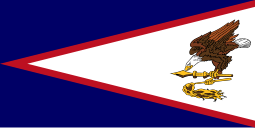 | |
| Use | Civil and state flag |
|---|---|
| Proportion | 1:2 |
| Adopted | April 17, 1960 |
| Design | A red-edged white triangle pointing towards the hoist charged with a bald eagle clutching a war club and a fly-whisk. The white triangle divides the dark blue field into two separate triangles. |
| Designed by | Uinifareti Rapi Sotoa[1] |
The flag of American Samoa consists of a red-edged white triangle pointing towards the hoist charged with a bald eagle clutching a war club and fly-whisk, with dark blue upper and lower triangles. Adopted in April 1960 to replace the "Stars and Stripes" as the official flag of the territory, it has been the flag of the Territory of American Samoa since that year. The colors used epitomize the traditional colors of the United States and Samoa.
The bald eagle and the blue, white and red colors symbolize the country's ties to the United States. The eagle holds a staff and a war club, two traditional symbols of the Samoan chiefs.[2]
According to the flag's designer, Uinifareti Rapi Sotoa, the white section represents the Manuʻa District. The two blue parts represent the two districts on Tutuila Island: The Eastern District and the Western District. The red in the middle is a symbol for the ocean between Tutuila Island and the Manuʻa Islands. The eagle is a confirmation of the unity between the United States and American Samoa. The fue and uatogi carried by the eagle represent the ability of Samoans to compromise but also that they can defend themselves when necessary.[3]
- ^ Sunia, Fofō Iosefa Fiti (2001). Puputoa: Host of Heroes - A record of the history makers in the First Century of American Samoa, 1900-2000. Suva, Fiji: Oceania Printers. Page 138. ISBN 9829036022.
- ^ Schyma, Rosemarie (2013). Südsee. DuMont Reiseverlag. Page 260. ISBN 9783770176946.
- ^ Sunia, Fofō Iosefa Fiti (2001). Puputoa: Host of Heroes - A record of the history makers in the First Century of American Samoa, 1900-2000. Suva, Fiji: Oceania Printers. Page 138. ISBN 9829036022.